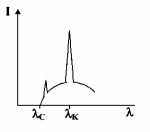Question
An electron beam is accelerated by a potential difference $$V$$ to hit a metallic target to produce X-rays. It produces continuous as well as characteristic X-rays. If $${\lambda _{\min }}$$ is the smallest possible wavelength of X-ray in the spectrum, the variation of log $${\lambda _{\min }}$$ with log $$V$$ is correctly represented in :
A.


B.


C.


D.


Answer :


Solution :
In X-ray tube, $${\lambda _{\min }} = \frac{{hc}}{{eV}}$$
In $${\lambda _{\min }} = In\left( {\frac{{hc}}{e}} \right) - InV$$
Clearly, $$\log {\lambda _{\min }}$$ versus log $$V$$ graph
slope is negative hence option (C) correctly depicts.
In X-ray tube, $${\lambda _{\min }} = \frac{{hc}}{{eV}}$$
In $${\lambda _{\min }} = In\left( {\frac{{hc}}{e}} \right) - InV$$
Clearly, $$\log {\lambda _{\min }}$$ versus log $$V$$ graph
slope is negative hence option (C) correctly depicts.
